- Focus and Scope
- Section Policies
- Peer Review Process
- Publication Frequency
- Plagiarism Check
- Author Fee
- License
- Publication Ethics
Focus and Scope
The scope of IJSEIT includes a wide spectrum of subjects including
Science (Mathematics, Physics, Biology, Chemistry, Social Science, Material Sciences, Food Sciences, Environmental Science, Earth Science, Space Science, Agricultural Science, Mechanical Quantum, Sustainable Development, Applied Physics, Communicable Diseases, Emergency Medicine, Micro-Nano Sciences, Environmental Health)
Engineering (Automotive Technologies, Material Engineering, Construction Materials, Design and Manufacturing, Dynamics and Control, Energy Generation, Utilization, Conversion, Fluid Mechanics and Hydraulics, Heat and Mass Transfer, Renewable and Sustainable Energy Technologies, Robotics and Mechatronics, Solid Mechanics and Structure, Thermal Sciences, Computer Vision and Robotics, Control Theory, Chemical ENgineering, Electromagnetic Waves, Microwave Techniques and Antennas, Embedded Systems, Integrated Circuits, VLSI Design, Testing, Microelectromechanical Systems, Microelectronics, Electronic Devices and Circuits, Power, Energy, and Signal)
Information Technology and Systems (Coding, Cryptography, and Information Protection, Communications, Networks, Mobile Computing, and Distributed Systems, Compilers and Operating Systems, Computer Architecture, Supply Chain Management, Image Processing, Speech Processing, Strategy, Change Management, Human Resources, System Development, and Implementation, Communications, Software Engineering, Technology Developments, Technology Futures, Data Mining, Information Retrieval, Big Data, Internet, Cloud Data Management, E-Government, Smart City, Knowledge Management, Service Innovation, Digital Enablement, Business Process Management, Web Semantics, Visual and Audio Information Systems, Scientific Computing, and Organisational Behaviour)
Section Policies
Manuscript checklist
many thanks for your contribution to our journal to review this article. Please make sure this article meets our criteria base on a manuscript checklist. feel review on revision form. if you didn't have time to feel on revision form please send our editor.
the manuscript checklist can be download here
revision form can be download here
Editors- doni fatah
- Hidayat Hidayat
- Khamdi Mubarok
- Yudha Negara
- Ananto Wicaksono
- Rifky Yusron
Peer Review Process
Publication of articles in International Journal of Science, Engineering and Information Technology (IJSEIT) is dependent solely on scientific validity and coherence as judged by our editors and/or peer reviewers, who will also assess whether the writing is comprehensible and whether the work represents a useful contribution to the field. ijseit acknowledged the effort and suggestions made by its reviewers.
Initial evaluation of manuscripts
The Editor will first evaluate all manuscripts submitted. Although rare, yet it is entirely feasible for an exceptional manuscript to be accepted at this stage. Those rejected at this stage are insufficiently original, have serious scientific flaws, or are outside the aims and scope of the ijseit. Those that meet the minimum criteria are passed on to experts for review.
Type of peer review
Submitted manuscripts will generally be reviewed by two to three experts who will be asked to evaluate whether the manuscript is scientifically sound and coherent, whether it duplicates the already published works, and whether or not the manuscript is sufficiently clear for publication. The method is blind peer review.
Review reports
Reviewers are asked to evaluate whether the manuscript:
- Is original by stating the objectives and gap clearly
- Is methodologically sound
- Follows appropriate ethical guidelines
- Has results/findings which are clearly presented and support the conclusions
- Correctly references previous relevant work
- Reviewers are not expected to correct or copyedit manuscripts. Language correction is not part of the peer review process.
Decision
Reviewers advise the editor, who is responsible for the final decision to accept or reject the article. The Editors will reach a decision based on these reports and, where necessary, they will consult with members of the Editorial Board. Editor’s decision is final.
Becoming a Reviewer
If you are not currently a reviewer for JOSI but would like to be added to the list of reviewers, please contact us. The benefits of reviewing for ijseit include the opportunity to see and evaluate the latest work in related research area at an early stage, and to be acknowledged in our list of reviewers. You may also be able to cite your work for ijseit as part of your professional development requirements. ijseit reviewers are volunteers who contribute their expertise to the science, thus no financial payments are made.
Publication Frequency
Regular Publication Schedule ofInternational Journal of Science, Engineering and Information Technology (IJSEIT) in July and December
A special issue might be conducted escalate on specific topic.
Plagiarism Check
Plagiarism screening will be conducted by Jurnal ijseit using Turnitin.
Rule of plagiarism screening:
- All the submitted paper on International journal of science, engineering, and information technology must be plagiarism check by Editor
- Editor using Turnitin to check plagiarism, paper must be containing similarity no more than 25%
- If paper script have a similarity about 25% to 30%, editor will be sent a notice to author to reduce similarity be 25%
- Paper who containing similarity more than 30% will be rejected
Author Fee
ijseit is an open access international journal, and we are very pleased to inform you authors that we are free from any Article Processing Charges or Article Publication Fee.
Readers can read and download any full-text articles for free of charge. Authors may get original reprint issue (if available) and also free shipping (for a regional author). For details about availability, please contact us.
License
This work is licensed under a Creative Commons Attribution-NonCommercial-ShareAlike 4.0 International License.
Copyright Notice
Please find the rights and licenses in International Journal of Science, Engineering and Information Technology (IJSEIT). By submitting the article/manuscript of the article, the author(s) agree with this policy. No specific document sign-off is required.
1. License
The non-commercial use of the article will be governed by the Creative Commons Attribution license as currently displayed on Creative Commons Attribution-NonCommercial-ShareAlike 4.0 International License.
2. Author(s)' Warranties
The author warrants that the article is original, written by stated author(s), has not been published before, contains no unlawful statements, does not infringe the rights of others, is subject to copyright that is vested exclusively in the author and free of any third party rights, and that any necessary written permissions to quote from other sources have been obtained by the author(s).
3. User/Public Rights
IJSEIT 's spirit is to disseminate articles published are as free as possible. Under the Creative Commons license, IJSEIT permits users to copy, distribute, display, and perform the work for non-commercial purposes only. Users will also need to attribute authors and IJSEIT on distributing works in the journal and other media of publications. Unless otherwise stated, the authors are public entities as soon as their articles got published.
4. Rights of Authors
Authors retain all their rights to the published works, such as (but not limited to) the following rights;
- Copyright and other proprietary rights relating to the article, such as patent rights,
- The right to use the substance of the article in own future works, including lectures and books,
- The right to reproduce the article for own purposes,
- The right to self-archive the article (please read out deposit policy),
- The right to enter into separate, additional contractual arrangements for the non-exclusive distribution of the article's published version (e.g., post it to an institutional repository or publish it in a book), with an acknowledgment of its initial publication in this journal.
If the article was jointly prepared by more than one author, any authors submitting the manuscript warrants that he/she has been authorized by all co-authors to be agreed on this copyright and license notice (agreement) on their behalf, and agrees to inform his/her co-authors of the terms of this policy. IJSEIT will not be held liable for anything that may arise due to the author(s) internal dispute. IJSEIT will only communicate with the corresponding author.
6. RoyaltiesBeing an open accessed journal and disseminating articles for free under the Creative Commons license term mentioned, author(s) aware that IJSEIT entitles the author(s) to no royalties or other fees.
7. MiscellaneousIJSEIT will publish the article (or have it published) in the journal if the article’s editorial process is successfully completed. IJSEIT's editors may modify the article to a style of punctuation, spelling, capitalization, referencing and usage that deems appropriate. The author acknowledges that the article may be published so that it will be publicly accessible and such access will be free of charge for the readers as mentioned in point 3.
Publication Ethics
EDITOR IN CHIEF
The Editor-in-chief is responsible for overseeing and coordinating the editorial process and provides some insight.
Responsibilities :
- Leading the editorial team in the production of 2 issues annually
- Providing strategic direction for [x journal] in collaboration with the editorial team
- Promoting the journal to authors and readers across [x institution/department/field of research]
- Recruiting new members for the editorial board team as required.
MANAGING EDITOR
Reports to the editor-in-chief, and oversees the operations of the journal, keeping the team on schedule. With section editors, makes decisions on submissions, and maybe the point of contact between the journal and authors.
Responsibilities:
- Reports to the Editor in Chief
- Supervision of editorial team: assigning articles, overseeing publication schedules
- Making decisions, in collaboration with the editorial team, on submissions
- Oversees the daily activities of the journal
- Checking plagiarism for the submitted paper
EDITOR
Reporting to the Managing Editor, an Editor manages the progression of articles from submission to publication by communicating with authors, peer reviewers, and copy editors regarding article reviews and revisions. Will often have the final decision whether a submission is accepted or rejected.
Responsibilities:
- Reports to the Managing Editor
- Point of contact between peer reviewers, editorial team, and authors during the publication process
- Makes decisions, in collaboration with the editorial team, on submissions.
SECTION EDITOR
Section editors prepare the manuscript for publication by formatting the article in accordance with journal policies and style guide. Academic journals typically publish in PDF and/or HTML, but other formats such as XML and EPUB may be used.
- Preparing manuscripts for publication
- Designing layouts for editors
- Providing guidance and assistance in choosing photos, graphics, and fonts
- Creating files in multiple formats (e.g. PDF, HTML).
REVIEWER
Provides constructive criticism of articles and recommendations on publication decisions Provides unbiased comments that should assist the author with revisions Maintains confidentiality of the review process during and after publication.
When reviewing a paper review must fulfill some aspect:
- Promptness: Any selected referee who feels unqualified to review the research reported in a manuscript or knows that its prompt review will be impossible should notify the editor and excuse himself from the review process.
- Confidentiality: Any manuscripts received for review must be treated as confidential documents. They must not be shown to or discussed with others except as authorized by the editor.
- Standards of Objectivity: Reviews should be conducted objectively. Personal criticism of the author is inappropriate. Referees should express their views clearly with supporting arguments.
- Acknowledgment of Sources: Reviewers should identify relevant published work that has not been cited by the authors. Any statement that an observation, derivation, or argument had been previously reported should be accompanied by the relevant citation. A reviewer should also call to the editor's attention any substantial similarity or overlap between the manuscript under consideration and any other published paper of which they have personal knowledge.
- Disclosure and Conflict of Interest: Privileged information or ideas obtained through peer review must be kept confidential and not used for personal advantage. Reviewers should not consider manuscripts in which they have conflicts of interest resulting from competitive, collaborative, or other relationships or connections with any of the authors, companies, or institutions connected to the papers.




















